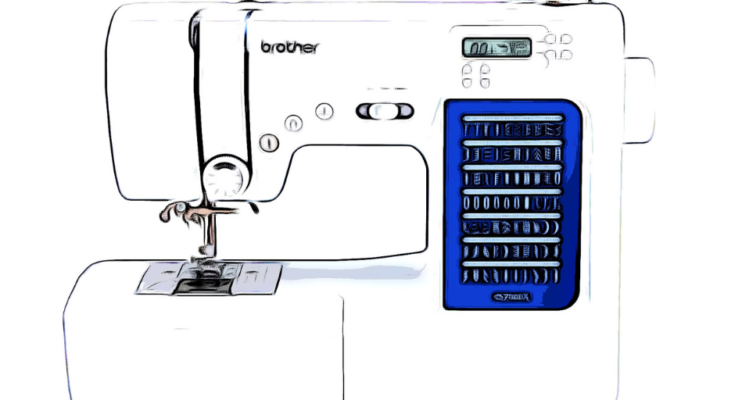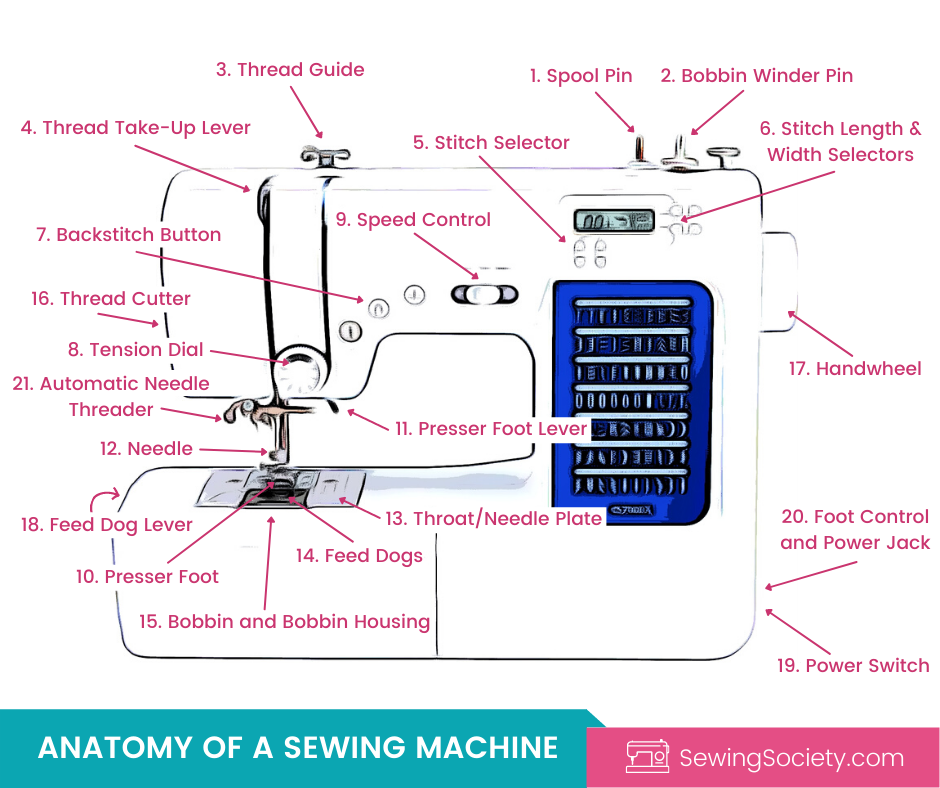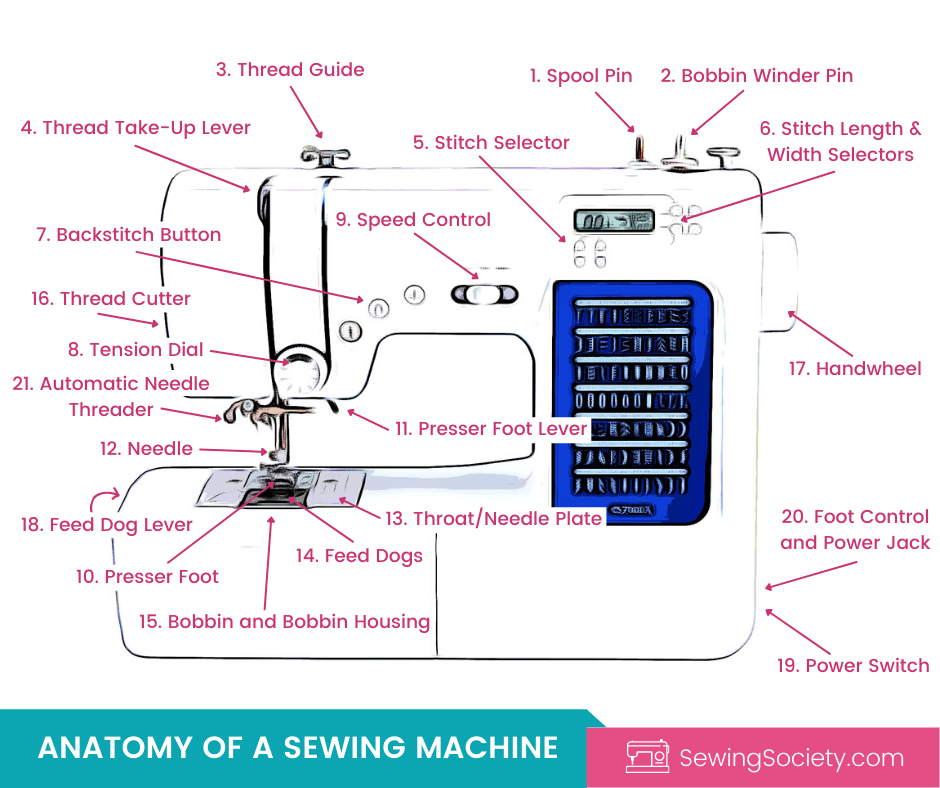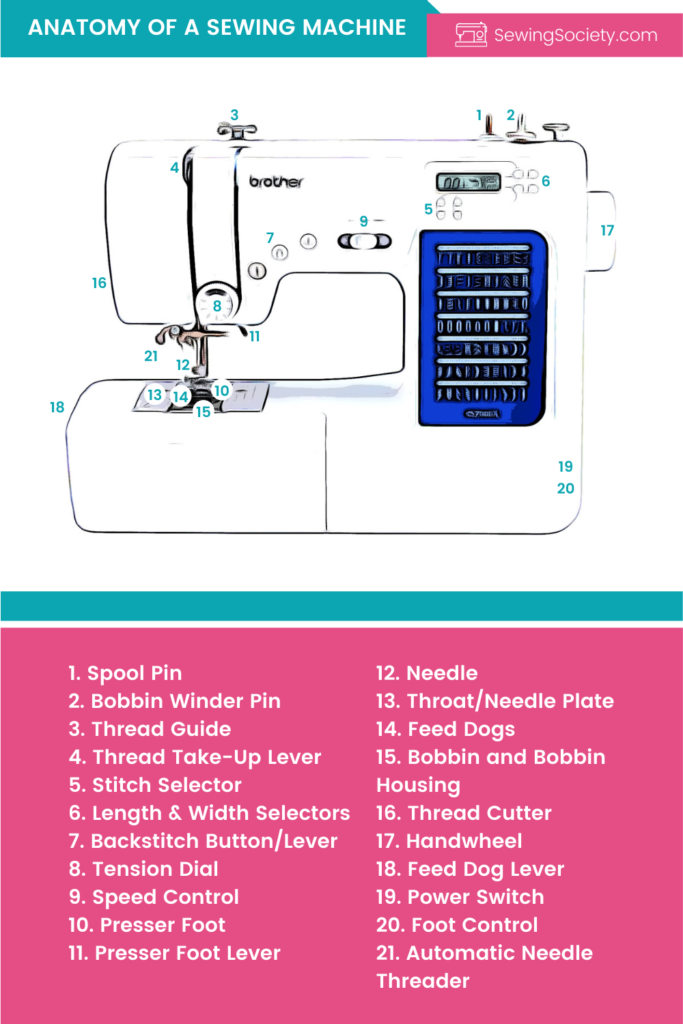Disclosure: This post may contain affiliate links. I earn a small commission when you click a link and make a purchase. Thanks for supporting SewingSociety.com!
If you’ve never used a sewing machine before, the first thing you need to learn is all the parts and their functions. That’s what this post is all about — I’m going to walk you through the anatomy of a sewing machine from top to bottom.
First, it’s important to realize that every sewing machine is a little different… The basic parts will be the same, but they may be in a different spot on your machine. I’ll give you some hints about what to look for, but your user manual will have a diagram that is specific to your machine that you can reference. Find each part on your sewing machine as you read through this guide.
The sewing machine in the following diagram is the Brother CS7000X. It’s a popular sewing machine for beginners. You can read my full review of the machine HERE.
Contents
1. Spool Pin
Starting at the very top of your machine is the spool pin. This is where you place your spool of thread. Sometimes the spool pin is vertical and sometimes it is horizontal. If your sewing machine has a horizontal spool pin, you’ll need to use a spool cap to hold your thread in place. The spool cap will look like a disk with a hole in the center.
Note: Most sewing machines will also have a spool pin attachment that you can add to your machine to use a second spool of thread. This is necessary if you’re sewing with a double needle. It often attaches to the bobbin winder pin.
2. Bobbin Winder Pin
The bobbin winder pin is also at the very top of your machine, usually on the far right. It is where you place an empty bobbin that you need to wind with thread. To engage your bobbin winder, you typically place a bobbin on the pin and push it to the right. This post is about the anatomy of a sewing machine, so I’m not going to go into how to wind a bobbin, but I have a post about it HERE.
3. Thread Guide
Most sewing machines have several thread guides that show you where to pull your thread through your machine. There is a thread guide at the very top of your machine, above the thread take-up lever, that you will use both when winding a bobbin and when threading your machine. It ensures that your thread does not get tangled as it comes off your spool.
4. Thread Take-Up Lever
Moving down the front of your machine is the thread take-up lever. It is a metal piece that goes up and down while you sew. When threading your machine, there is a loop on this lever that catches your thread.
5. Stitch Selector
Some sewing machines only have a few stitch options while others have hundreds. The stitch selector allows you to choose what stitch your sewing machine will perform (straight, zig-zag, buttonhole, decorative, etc.).
The stitch selector is usually on the front/right of your machine… If your sewing machine is mechanical, the stitch selector will likely look like a knob that you turn to the desired stitch. If your sewing machine is computerized, it will likely have a small LCD display where you can choose the number that matches the stitch pattern you want to use.
6. Stitch Length and Width Selectors
The length and width selectors can either be buttons or knobs. They are usually found on the front/right of your machine. You should always test your stitch settings out on scraps of fabric until you get the look you want.
7. Backstitch Button/Lever
The backstitch button could be found in several different locations. If you’re using a mechanical sewing machine, it is usually on the front/right of your sewing machine at the bottom. To engage the backstitch, you simply press and hold the lever down while you sew. If you’re using a computerized sewing machine, the backstitch button could be anywhere on the front of your machine. I typically see it near the thread take-up lever. You press and hold the button to stitch in reverse.
8. Tension Knob or Dial
The tension dial controls how tight your upper thread is as it is pulled through your sewing machine. When setting the tension on your sewing machine, the goal is to have the stitch look the same on both sides of your fabric. The dial/knob can be anywhere, but it is usually near the thread take-up lever. The bobbin has its own tension adjustor.
9. Speed Control
The speed control is usually a sliding lever on the front/center of your sewing machine that determines the speed of your stitching. It is smart to start on a lower setting and work your way up to a faster setting.
10. Presser Foot
The presser foot is attached to the presser foot holder near the needle. It is easy to change out your presser feet depending on what you want to sew. The presser foot applies constant pressure on your fabric and ensures your fabric stays flat.
11. Presser Foot Lever
The presser foot lever is usually found next to the presser foot, either to the right or behind the foot. This lever lowers and raises the presser foot. The presser foot should always be raised when putting fabric under your needle, and then lowered before sewing.
12. Needle
Your sewing machine needle is located above the presser foot and can be changed out to fit the fabric you are sewing. You’ll need to change your needle a lot, so make sure to buy plenty of extras.
13. Throat Plate
The throat plate is the metal piece just below your presser foot. It has holes or slots for your needle to pass through to meet the bobbin thread. Many throat plates also have measurement lines to help you get accurate and consistent seam allowances.
14. Feed Dogs
The feed dogs are under the presser foot. They look like little teeth that stick out from the needle plate. These feeds pull your fabric and move it through the presser foot. The speed of the feed dogs can be adjusted by a speed control or the pressure you put on the foot control.
15. Bobbin and Bobbin Housing
Bobbins can either be drop-in or front-loading, which will determine the location. If the bobbin is a drop-in, then the bobbin housing will be on the throat plate, or close to it. If the bobbin is front loading, then the bobbin housing will be under the throat plate and usually accessed by taking off the accessory holder on the front of your machine. Bobbins hold the thread that is on the underside of garments when sewn.
16. Thread Cutter
The thread cutter cuts your thread when you are done sewing. This can either be found as a button on the front of your machine, or it can be a blade on the left side of your machine.
17. Handwheel
The handwheel is found on the right side of your sewing machine. It is a large knob you can turn to manually move your needle up and down. The important thing to remember is that you should always turn the handwheel towards you. If you turn it backwards, it can mess up the timing of your machine.
18. Feed Dog Lever
The feed dog lever is usually located on the left side or back of your sewing machine. This switch lowers and raises your feed dogs. You’ll only want to disengage your feed dogs for things like free-motion quilting.
19. Power Switch
The power switch is usually found on the right side of your sewing machine, near where the power cord goes in. When you turn on your sewing machine, the light should turn on.
20. Foot Controller
The foot controller is placed on the floor to start and stop the needle movement. You can control the speed by how much pressure you put on the foot control. This control is attached to a cord that is plugged into the side of your machine. The power jack and foot controller jack are usually found on the right side or back of your sewing machine.
21. Automatic Needle Threader
Not all sewing machines have an automatic needle threader, but if you have one, it will be a little lever to the left of your needle. You pull it down when threading your machine and it will catch your thread and pull it through the eye of your needle. It’s a very handy feature!
Remember, every sewing machine is going to look a little different and have different functions and features. A higher-end sewing machine may have bonus features that are not listed here, such as a needle up/down button or a dual feed control. Make sure you read your user manual so you can get the most out of your machine!
If you haven’t bought a sewing machine yet, check out our post on the Best Sewing Machines for Beginners. I’ve hand-selected a couple of machines that will set you up for success but don’t cost a lot of money. I highly recommend the Brother CS7000X because it will give you the most bang for your buck!
I’ve also written a sewing machine troubleshooting book that is a nice reference to keep near your sewing machine for when you encounter problems. Get your copy on Amazon!
Help others learn to sew. Share this post on Pinterest!








very clear and good article easy to understand. Thank you